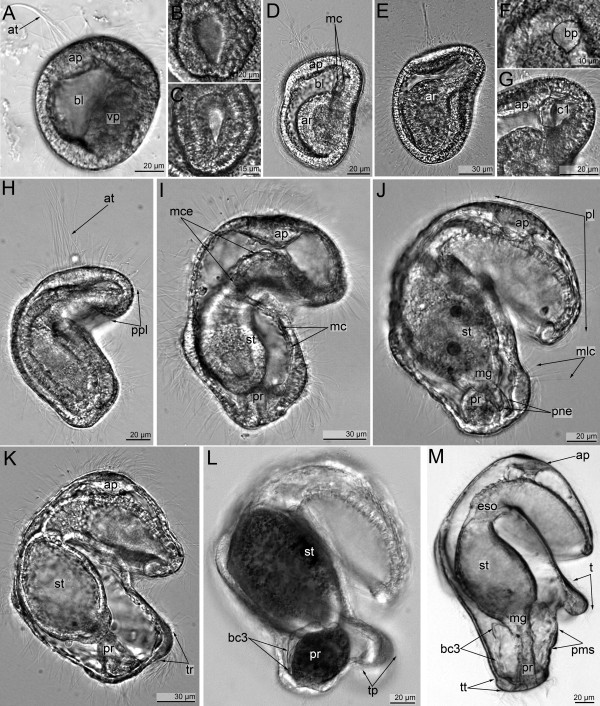Figure 1.
Embryonic and larval development of Phoronopsis harmeri (photographs of live animals). Whole embryos and larvae are in lateral right view with anterior up (A) The early gastrula has a spacious blastocoel (bl), a flat vegetal pole (vp), an apical plate (ap), and an apical tuft (at). (B) Rounded blastopore of the early gastrula. (C) Flask-shaped blastopore of a mid-gastrula stage. (D) Ventral side of a mid- gastrula with rounded archenteron (ar) and mesodermal cells (mc) in the blastocoels above the archenteron. (E) The late gastrula I has a large apical plate, an elongate archenteron (ar), and a small coelomic cavity in the anterior body part. (F) A tear-shaped blastopore (bp) of the late gastrula I. (G) The anterior body part of the late gastrula I with coelomic cavity (c1) and apical plate (ap). (H) The late gastrula II shows the precursor of the preoral lobe (ppl), which resembles an epidermal fold above the mouth. (I) The preactinotrocha has an apical plate (ap), stomach (st), proctodeum (pr), two tiers of the mesodermal cells (mc), and well developed muscles of the esophagus (mce). (J) The young actinotrocha is the first feeding stage with a well-developed preoral lobe (pl), complete intestine with stomach (st) and proctodaeum (pr), motionless cilia (mlc) along the tentacular ridge, and two protonephridial channels (pne). (K) A 6-day-old actinotrocha has a well-developed tentacular ridge (tr) and a short trunk. (L) A 13-day-old actinotrocha has precursors of the tentacles (pt) along the tentacular ridge, a longer trunk, and a small trunk coelom (borders are indicated as bc3). (M) The actinotroch larva with three pairs of tentacles has six short tentacles (t), complete intestine with esophagus (eso), stomach (st), midgut (mg), and proctodaeum (pr), a long trunk with trunk coelom, a terminal telotroch (tt), and the precursor of the metasomal sack (pms).

